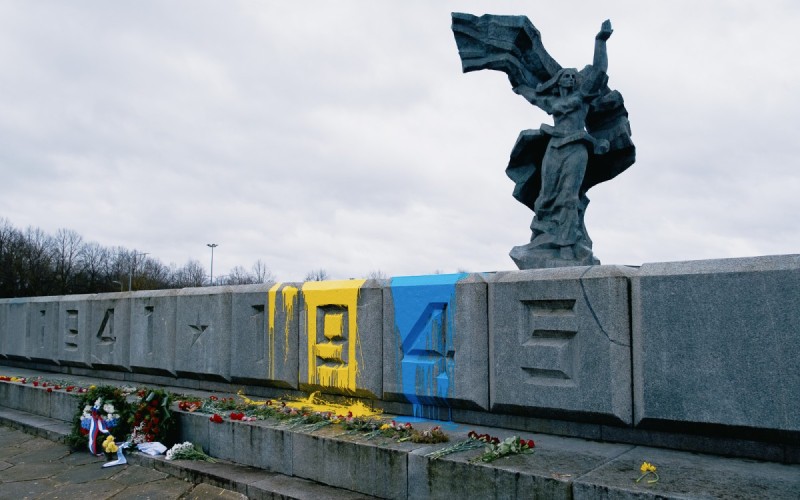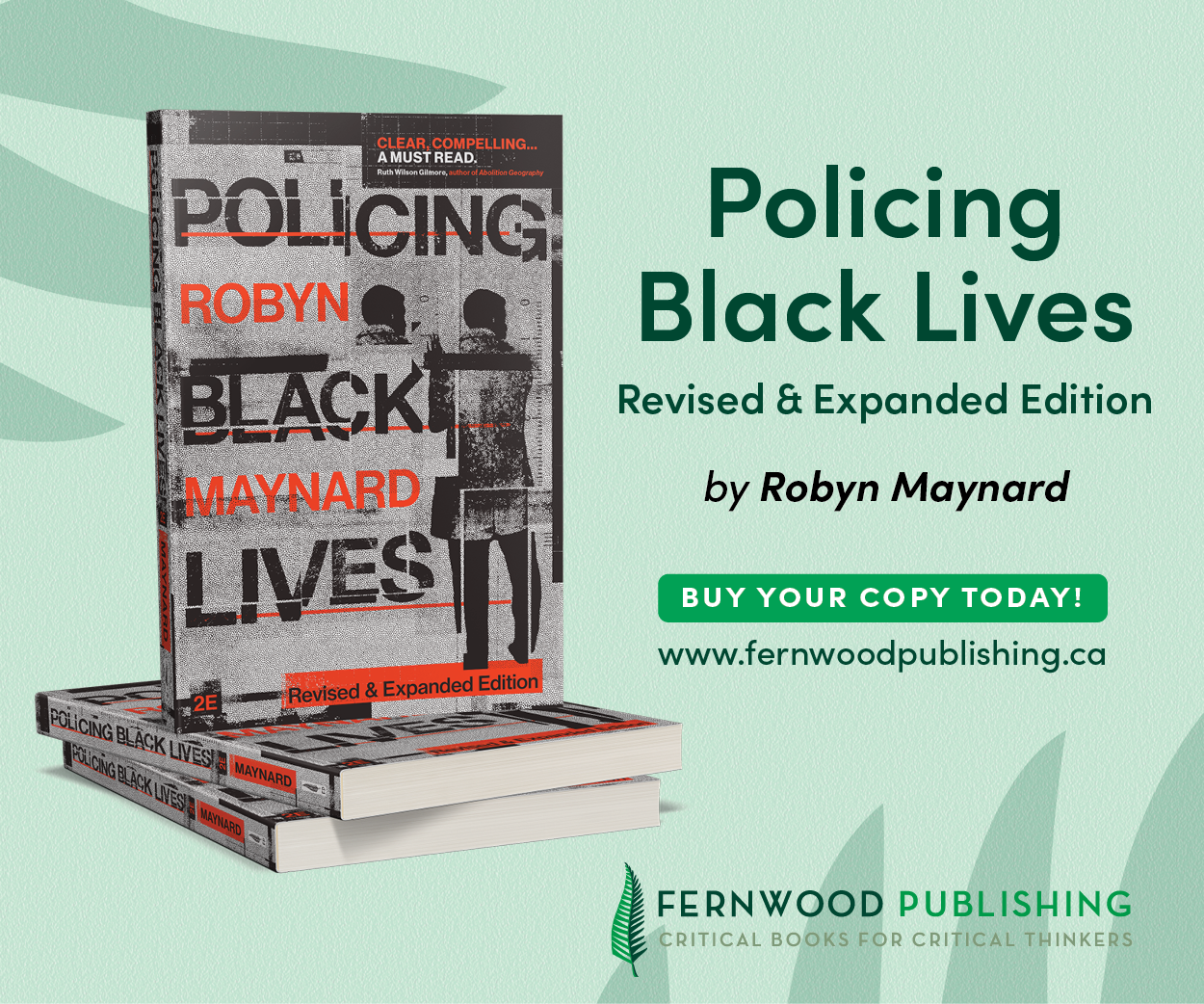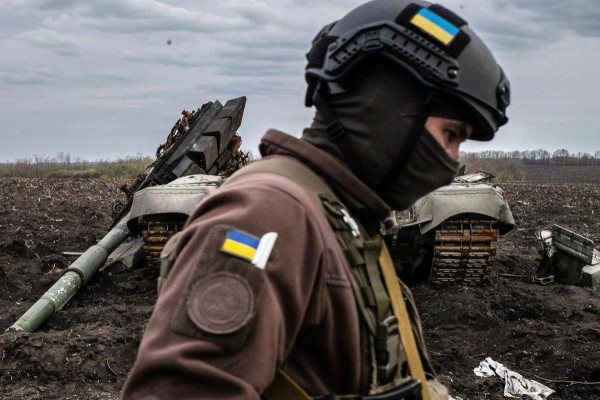Making sense of the senseless war in Ukraine
New book co-authored by anti-war activist Medea Benjamin casts serious doubts on the mainstream interpretation of events

Soviet-era monument in Riga, Latvia, which was splashed with the colours of the Ukraine flag the day after Russia invaded in February 2022. Photo by Kārlis Dambrāns/ Flickr.
General Nathan Bedford Forrest once said that the secret of his success was that he “got there first with the most men.” It turns out that this is not only a good way to win military battles, but to fight propaganda wars as well.
We all like morally neat narratives, whether our politics are right, left, or middle. The narrative of Volodymyr Zelensky in his olive-green T-shirt, more a statue than a man, bravely defying the cynical, scheming, cowardly, pit bull-faced Putin and his naked imperialism is a narrative too entertaining to give up easily, once one has assented to it. This is the story that has gotten there “first with the most.”
For those who have accepted the mainstream narrative, Medea Benjamin and Nicolas Davies’ War in Ukraine: Making Sense of a Senseless Conflict might at first appear shocking and biased. But that is always the way when dominant positions are questioned.
This book has been referred to as a “primer” on the Russia-Ukraine war, and that is just exactly the right description for it. Yes, “primer” has connotations of something a bit too basic and boring, but this book is not boring; it is concise, to the point, and the historical material it covers casts serious doubts on the mainstream interpretation of events.
Here are some of the key questions War in Ukraine proposes to address:
What happened in Ukraine in 2014? Was there really a “coup”? What role did the United States and Russia play in those pivotal and complex events, which Western corporate media deceptively abbreviate as “the Russian annexation of Crimea”?
Why did civil war break out in eastern Ukraine in 2014? What was the 2015 Minsk II agreement? Why and how did it fail to end the civil war over the next seven years? How did that set the stage for the Russian invasion?
And why did Russia decide to invade Ukraine? How important were provocations by the West? Don’t Ukrainians have the right to join NATO if they want? And are neo-Nazis a powerful influence in Ukraine, or just a red herring?
Also, how did NATO, a military alliance built to defend Europe from attack by the USSR, outlive its purpose, expand beyond its borders (or any borders at all) and end up invading Yugoslavia, Afghanistan and Libya—all a long way from the North Atlantic? How did that affect Russia’s view of NATO expansion?
These and other questions are a lot for a little book of less than 200 pages to deal with, but it makes an admirable start. In fact, the questions alone are refreshing, given the level of uninformed conformity of thought the war has given rise to in the establishment press and much of social media.
Since there will inevitably be cries of “Putin stooge” for anyone who pokes a hole or two in the politically correct narrative (we are supposed to believe, it seems, there are cheques in the mail from Moscow for all such people) it must be said from the outset that there is no support for the Russian invasion in this book:
In our view, the Russian invasion of Ukraine was not only criminal, but also a catastrophic move and a terrible miscalculation. Veteran US diplomat Chas Freeman called it “the worst strategic decision that any Russian government has made since Czar Nicholas II decided to go to war with Japan in 1904.”
With some political will and compromises on both sides, the tragedy of war in Ukraine was entirely preventable. Instead, as Noam Chomsky put it, we saw “criminality and stupidity on the Kremlin side, severe provocation on the US side.”
This exemplified the institutional insanity of the political classes who rule our world. Could Putin really believe that Russia’s very existence was under such immediate threat that invasion was the only answer? Could Western leaders really believe that Ukraine’s right to join NATO and to reimpose its sovereignty over Donbas and Crimea were causes worthy of jeopardizing millions of lives or risking nuclear war?
Benjamin and Davies assert the Americans backed (and “to some degree engineered, although the full extent of that engineering remained shrouded in secrecy”) the Maidan coup of 2014, which has been presented by mainstream media as supported by an overwhelming majority of Ukrainians. In fact, “[t]he widespread ambivalence of Ukrainians toward the new government was illustrated in a Gallup poll conducted two months after the coup. The poll found that only 51.2 percent agreed that the post-coup government was in fact the legitimate government of Ukraine.”
The response in the Donbas to the coup (again, this response being one of the many things largely ignored in mainstream media) was for anti-coup protestors to proclaim the Donetsk People’s Republic (DPR) and the Luhansk People’s Republic (LPR). Subsequent referenda on attaining independence from Ukraine showed huge majorities for independence. There is even evidence that suggests that for quite some time, since the 1990s even, a large majority of Crimeans have not wanted to be part of Ukraine. Indeed, in March of 2014, the “Ukrainian military withdrew from Crimea… after about half its troops there defected to join the Russian military.”
The Ukrainian military set about trying to forcibly reclaim the Donbas. But “resistance and defections from soldiers who were reluctant to fight their own people” led to the job being handed over increasingly to nationalist and far-right groups, such as the neo-Nazi Azov Battalion.
Enter the Minsk accord of September 2014, and then Minsk II of February 2015 to bring an end to the violence. Of the approximately 14,400 people who died in this war from 2014 to 2021, the “vast majority” of them were killed before Minsk II. The way was cleared, therefore, for “legitimate and internationally monitored referenda and elections in the DPR and LPR, new laws to establish the autonomous status that Ukraine agreed to grant them, and the return of control of the international border with Russia to the government of Ukraine.”
This did not happen, however. Particularly revealing here is chapter two: “The Success and Failure of the Minsk II Peace Plan” where Zelensky comes across as a man who started out well as president but was eventually bent in the wrong direction by the hard right of his country. As a television comedian, Zelensky had “made fun of the post-coup government’s subservient relations with the United States and of Ukraine’s neo-Nazis.” Though politically inexperienced, Zelensky handily defeated the incumbent Petro Poroshenko in the 2019 presidential election, gaining “overwhelming support from the Russian-speaking East and South, and large majorities across the country… [H]is meteoric rise to power was built on promises of peace and unity that seemed to reflect the politics of Victor Yanukovych more than the Maidan movement that overthrew him.”
But the inspiring political rags to riches story took a tragic turn. The right was not enthusiastic, and Dmytro Yarosh, a prominent right-wing leader, even threatened Zelensky’s life in a TV interview because of Zelensky’s attempts to bring peace to the Donbas. When Zelensky ordered troop withdrawals from the region, some military units refused. Extreme right-wing groups replaced withdrawn soldiers with volunteers and “set up armed checkpoints to impede the withdrawal.”
Stephen Cohen, a highly respected expert on Russian history, said, “the chance for Zelensky, the new president who had this very large victory, 70 plus percent, to negotiate with Russia an end to that war, it’s got to be seized. And it requires the United States, basically, simply saying to Zelensky, ‘Go for it, we’ve got your back.’”
But the United States did not have Zelensky’s back. Its “antipathy to Russia that it shared with the extreme right in Ukraine effectively made it an ally of Svoboda, Right Sector, and the Azov Regiment in their campaign to undermine the peace process.” Zelensky’s large public support collapsed and dropped to around 17 percent “for two years, until the Russian invasion thrust him into the classic role of a wartime leader trying to save his nation, like others throughout history.”
All of this background information helps in effect to give the lie to any claim that the US government is now helping Ukraine from some genuine concern over the interests of its people. When America had a chance to help the Ukrainian people and back their popular president against fascists, they refused (in the meantime, the US was arming and training Ukraine up to NATO standards, even though Ukraine was not in NATO).
Most revealing is the fact that in March and April of 2022, after the Russian invasion, Ukraine and Russia were very close to a deal. Then Boris Johnson, the British prime minister, made a surprise visit to Kyiv on April 9 and pressured Zelensky to defeat the Russians militarily rather than talk to them. US Secretary of Defense Lloyd Austin gave the same message. Together, America and Britain killed the deal.
Defenders of the mainstream narrative often point out that as a sovereign nation, Ukraine has the right to join NATO if NATO will have it, and that the possibility of this happening is a bogus excuse for Russian aggression. But Benjamin and Davies question NATO as a merely defensive alliance, pointing out that it has been used aggressively in Serbia, Afghanistan and Libya, for example. The promise by US Secretary of State James Baker to then Soviet Premier Mikhail Gorbachev in 1990 that NATO would expand “not one inch eastward” was broken repeatedly, as further countries were added to NATO while the Warsaw Pact was disbanded. Benjamin and Davies write:
In 1997, fifty prominent foreign policy experts urged President Clinton to stop NATO expansion eastward, calling it a policy error of “historic proportions” that would “unsettle European stability.” They also said it would be expensive and unnecessary, given that Russia posed no threat to its Western neighbors. But Clinton had already made a commitment to opening up NATO during the 1996 election, reportedly out of concern that saying “no” to Poland would lose him critical Polish-American votes in the Midwest.
Furthermore, George Kennan, “the intellectual father of US containment policy during the Cold War” warned in 1998 that a new Cold War was being initiated by NATO expansion: “I think it is a tragic mistake. There was no reason for this whatsoever. No one was threatening anybody else.”
Benjamin and Davies discuss the interventions in Yugoslavia and point out that the famous NATO Article 5 was invoked for the first time within 24 hours of the attacks of 9/11, helping to lead the way to the occupation of Afghanistan and the two decades long debacle there. Iraq and Libya are also discussed to make the point that NATO does not have a habit of making peace and avoiding war.
Finally, it should also be noted that William Burns, US ambassador to Moscow in 2008, said in a letter to Condoleezza Rice that “Ukrainian entry into NATO is the brightest of all red-lines for the Russian elite (not just Putin). In more than two and a half years of conversations with key Russian players, from knuckle-draggers in the dark recesses of the Kremlin to Putin’s sharpest liberal critics, I have yet to find anyone who views Ukraine in NATO as anything other than a direct challenge to Russian interests.”
One issue I would like to have seen addressed was that of Putin’s alternatives to invading Ukraine. Given that this book explicitly condemns the invasion, what could or should Russia have done instead about the issues which provoked it?
However, War in Ukraine can not thoroughly answer all the questions, and it does not pretend to. It is, however, a great start. Greater length, detail, and thoroughness would be pluses in one sense, but in another, the world of politics has great need of relatively brief books of this nature as primers on all manner of issues, foreign and domestic. God knows how many times we feel overwhelmed by information and opinions bereft of context and which we are not sure to trust: but we feel we don’t have the time to get the information needed to outrun the possible lies that vie for our attention and approval. As a primer, a start that opens up the issues and shows the problems within a dominant narrative that ignores a great deal of relevant facts and history, this book is a great success.
J.W. Horton is a sessional instructor at the University of Manitoba in the Department of English, Theatre, Film & Media. He is also an essayist and fiction writer. Visit his blog, or follow him on Twitter.





_in_The_Hague_600_400_s_c1.png)




